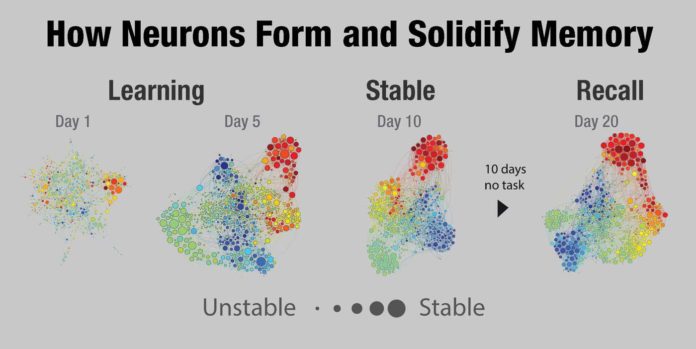Why are some memories stable over decades, while others fade within minutes?
To find out the answer, scientists at the Caltech used mouse models and determined strong and stable memories that are encoded by “teams” of neurons all firing in synchrony. These neurons provide redundancy that enables these memories to persist over time.
Scientists primarily developed a test, where they examined mice’s neural activity as they learn about and remember a new place. The mouse was then placed in a straight enclosure, about 5 feet long with white walls.
Unique signs marked different locations along the walls – for instance, a plus symbol close to one side end and an angled slash near to the center. Sugar water was placed at either end of the track.
When the mouse explored, the analysts estimated the movement of specific neurons in the mouse hippocampus that are known to encode for places.
When an animal was initially placed in the track, it was unsure of what to do and wandered left and right until it came across the sugar water. In these cases, single neurons were activated when the mouse took notice of a symbol on the wall.
But over multiple experiences with the track, the mouse became familiar with it and remembered the locations of the sugar. As the mouse became more commonplace, more and more neurons were activated in synchrony by seeing each symbol on the wall. Mostly, the mouse recognized where it was with respect to each unique symbol.
How memories fade over time?
Scientists then retained the mice from the track for as long as 20 days. After coming back to the track after this break, mice that had formed strong memories encoded by higher numbers of neurons remembered the task rapidly.
Even though a few neurons demonstrated distinctive activity, the mouse’s memory of the track was recognizable when analyzing the action of large groups of neurons. In other words, using groups of neurons empowers the brain to have redundancy and still review memories regardless of whether some of the neurons fall silent or are damaged.
Postdoctoral scholar Walter Gonzalez said, “Imagine you have a long and complicated story to tell. To preserve the story, you could tell it to five of your friends and then occasionally get together with all of them to re-tell the story and help each other fill in any gaps that an individual had forgotten. Additionally, each time you re-tell the story, you could bring new friends to learn and therefore help preserve it and strengthen the memory. Analogously, your neurons help each other out to encode memories that will persist over time.”
“For years, people have known that the more you practice an action, the better the chance that you will remember it later. We now think that this is likely, because the more you practice an action, the higher the number of neurons that are encoding the action. The conventional theories about memory storage postulate that making the memory more stable requires the strengthening of the connections to an individual neuron. Our results suggest that increasing the number of neurons that encode the same memory enables the memory to persist for longer.”
The study is published in the journal Science.
